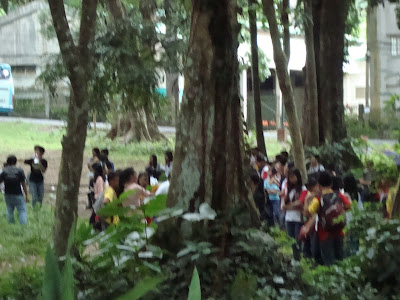Pineapple is ready for harvest when the "eyes" are filled, and the base of the fruit becomes yellow advancing upward.


Dr Abe V Rotor
Living with Nature School on Blog
Fruits and vegetables are highly perishable. Here is list of do's and
don'ts in harvesting, in order to reduce loss and enhance quality.
1. Fruits like mango, avocado, chico, caimito and guava should be harvested
with a picking pole with a catching bag.
Siniguelas: Ready-to-pick fruits are shiny, well formed and purplish.
Sampalok or tamarind: Pods are dull brown, well formed. Press rind if loose and open. Semi-ripe (manibalang, Tag) and fully ripe brown (kalanakang, Ilk) are eaten directly, or made into jelly or jam.


Sapote: Ready to pick fruit are full and rounded, with tinge of brown or purple.
Shrinks as it ripens.
Guyabano: The fruit is harvested green, it ripens in two to three days. Fruit shown in this photo is immature when harvested, it will simply go to waste.
2. Harvest pechay, mustard, lettuce, cauliflower, with sharp knife close
to the root and trim at the same time. Uprooting is tedious and may predispose
the harvest to early deterioration.
3. Harvest green corn, melon, pineapple and the like, in the morning, they
are sweeter. They have lower sugar content in the afternoon.
4. Avoid harvesting leafy vegetables early in the morning, they are brittle,
and easily break and rot. Allow them to get supple and the dewdrops to
evaporate.
5. Harvest root and tuber crops (e.g. radish, carrot) when they are large
enough or at marketable size. When over mature the pith is hard and even
dry.
6. Harvest onions, garlic and potato when the top begins to dry out, spreads
out and topples.
7. Do not let yam (sinkamas) and ginger to over stay in the field, otherwise
they become tough and fibrous.
8. Harvest lettuce, pechay and mustard before they flower.
9. For cabbage, the head should be well formed, if
cracked it is over mature. Cauliflower head is well formed, clean white
or cream.
10. Harvest papaya, as soon as 10 to 15 percent of the fruit's surface is
yellow to yellow orange.
11. Pineapple is ready for harvest when the "eyes" are filled, and
the base of the fruit becomes yellow advancing upward.
12. Apply the simple thumbnail test on the following:
- Sweetcorn exudes milky sap
- Okra snaps easily at the tip
- Upo, patola, cucumber easily
give way and exude sap
- Cowpea, sitao, batao,
sigarillas snap easily
- Squash when fully mature
does not give way
- Chico, sampalok - scrape
lightly, immature if green










































